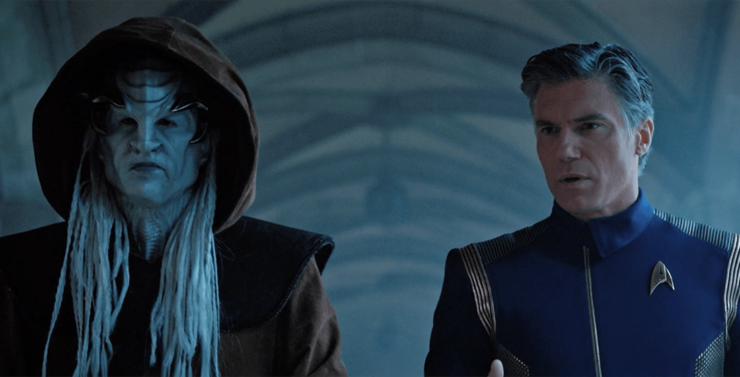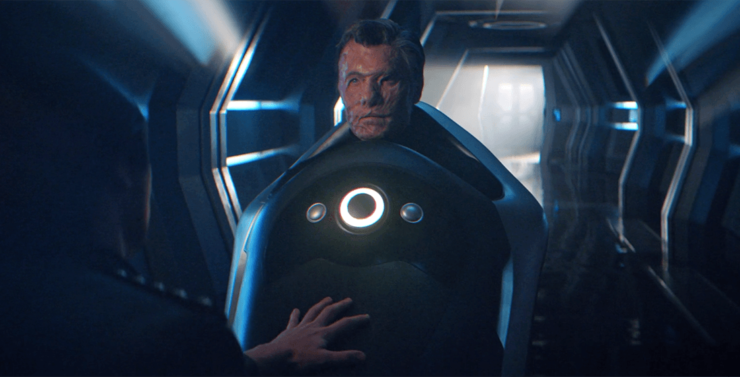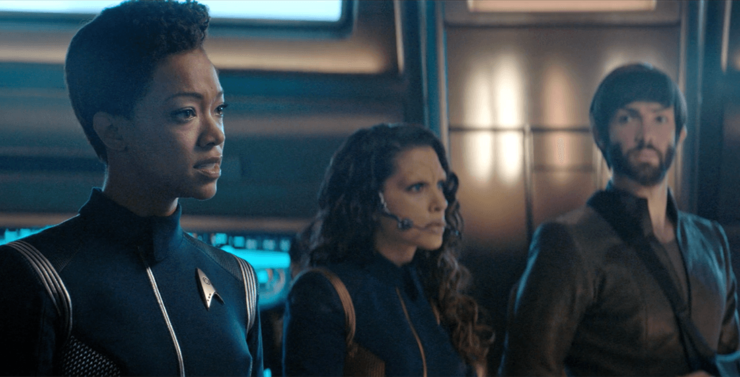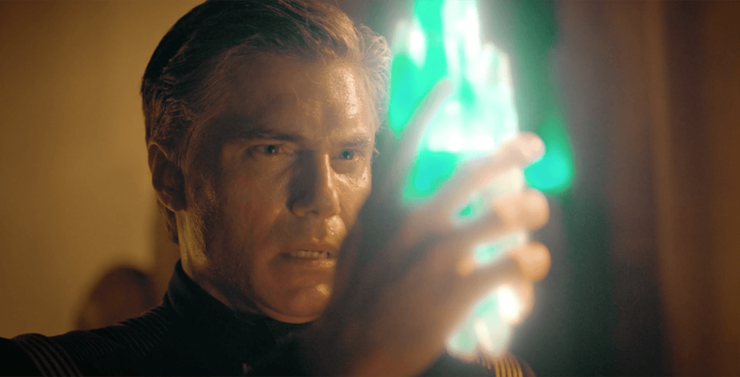Time time time, see what’s become of me
While I look around for my possibility–Paul Simon, “Hazy Shade of Winter”
Doing a prequel is always a dodgy proposition. It’s very easy to do it wrong, and in such a way that the material to which it’s a prequel no longer makes sense. (To give a shooting-fish-in-a-barrel example, Star Wars describes the Force in terms of being a long-dead religion that Darth Vader is pretty much the only person who follows anymore, not something that was a major thing within the adult lifetimes of all the characters, as later established in The Phantom Menace and its two sequels.)
It can be done right, however. AMC’s Better Call Saul is a textbook example, and for the umpteenth time, Star Trek: Discovery’s pulling it off, too.
The latest of the seven signals is over Boreth, a Klingon world first seen in The Next Generation’s “Rightful Heir,” established there as the world on which Kahless promised to return. The planet has a monastery, which was mentioned twice more, on Deep Space Nine’s “The Way of the Warrior” and Discovery’s “Point of Light.”
We return to the world and learn that it has a second purpose beyond the Story of the Promise: it’s also where a dedicated group of Klingons, called the Timekeepers, protect the Klingons’ time crystals.
Now there’s an untold story here, because Leland said two weeks ago in “The Red Angel” that the Federation was worried about the Klingons achieving time travel, because they could easily go back to the Mezozoic and blow up Earth. But we find out this week that they’ve had time travel all along—which raises the question of why they don’t use it to go back to the Mezozoic and blow up Earth. Instead, they’ve hidden the crystals on their most sacred world, and put it in trust to monks who are sacrosanct. Even the High Council has no authority over them. So what happened to cause that?
That, however, is a story for another today. For now, Discovery has been sent here and they happen to need a time crystal. Tyler arranges for them to get safe passage to Boreth thanks to his special relationship with L’Rell. However, there are two problems: the monks won’t just give up a time crystal (in fact, they’re very likely not to) and L’Rell refuses to let Tyler go down there. The Klingon Empire thinks he’s dead, and he needs to stay that way by not setting foot on a Klingon world. Pike volunteers to go instead. After all, all sentient life in the galaxy is at stake.

Pike shows up at the monastery and gets the same disdain that Klingons generally have for anyone who is not a Klingon. The monastery is run by an albino Klingon named Tenavik—whom we eventually learn is L’Rell’s and Tyler’s son all grow’d up. Time passes weirdly around the time crystals, which is how he’s an adult already. (The presence of time crystals on Boreth also makes a nice subtle retcon explaining how the monks would, a hundred years hence, age their clone of Kahless to adulthood in the months leading up to “Rightful Heir.”) Tenavik is played by Kenneth Mitchell, now on his third Klingon, having played Kol throughout the first season and Kol-Sha in “Point of Light.”
When he grabs one of the time crystals, Pike is given a vision of the future and told by Tenavik that, if he takes the crystal away from Boreth, that vision will come to pass no matter what.
And of course the vision he gets is a dramatization of what Commodore Mendez described in “The Menagerie“: during a training exercise on a Class-J starship, a baffle plate ruptured and exposed the cadets and Pike to radiation. He got most of the cadets to safety, but in the process was so badly injured that he was stuck in a convalescent chair, able only to communicate in the most minimal manner.
We’ve already seen Anson Mount play a version of the Jeffrey Hunter Pike, with a certain amount of the Bruce Greenwood Pike thrown in for good measure, but this week we sadly get to see him play the Sean Kenney Pike, as the captain sees himself scarred and badly injured. And 2010s technology is able to portray the injured Pike in a much more devastating manner than 1960s technology could, as we see that the chair-bound Pike is in constant agony. For a long time, the limitations of Pike’s chair—he could only signal “yes” or “no” through beeps—has rightly been viewed as a failure of anticipation by Gene Roddenberry in 1966 of medical advances in the next thirty years, much less the next three hundred. This episode proposes an alternative: that Pike could only say yes or no because he was in such constant agony that that was the best he could do.
And here is why Discovery is a good prequel: once again, they’ve used having Pike as a regular to add texture to the events of “The Menagerie.” In this case, throughout the framing sequence of the first part of the 1966 story, Pike is constantly telling Spock “no” when the latter says he’s taking Pike to Talos IV. By revealing that Pike knew this was his fate, that he accepted it in order to save quadrillions of lives, it adds so much to Pike’s insistent “no.” He doesn’t want Spock to bring him to Talos IV because he already knew years earlier that this would be his fate, and he’s accepted it.
On top of that, Pike gets his Captain Moment, when he overcomes the horror of what he’s seen because the horror of what’ll happen if he doesn’t take the time crystal is far worse. He’s convinced that the signals sent them to Boreth to get a time crystal, and he’s equally convinced that it’s their only hope to do what Gabrielle Burnham has been unable to do: stop Control from wiping out all sentient life. So he antes up, kicks in, grabs the time crystal, and accepts his rather awful fate.

The rest of the episode moves the plot pieces forward, with the added bonus of some fun pairings. Georgiou has gone off to find the Controlled Leland (see what I did there?), and Burnham thinks they should be joining her. Pike and Saru point out that Control wants the Sphere data, which is pretty well stuck in Discovery’s computer, so it’s best to keep Discovery as far from Leland as possible.
However, Tyler learns that a Section 31 ship hasn’t checked in, which never ever happens. So Burnham takes a shuttle to investigate, thus keeping Discovery and its Sphere data away. Burnham is surprised twice by Saru, in command while Pike is playing with time crystals on Boreth. The first is when Saru readily acquiesces to her request to go on this side mission; the second is when Saru orders Spock to accompany her. Burnham doesn’t want the company, but Spock insists, backed up by an order from their superior.
While this part of the story is mostly there to move the plot along, it also provides us with Burnham and Spock straight-up working together without the angst of family. (Having said that, there’s a lovely moment at the top of the episode where Amanda calls to check in on Burnham and see how she’s doing after the awful experiences with her biological mother last week, and Spock walks in on the end of it, giving Amanda a chance to say that she loves them both, which was just a great “awwwwwww” moment.) Brother and sister actually make a dandy team, and both Ethan Peck and Sonequa Martin-Green continue to kill it, especially the former. (“I apologize for being so slow,” he says calmly after calculating the exact current needed to keep the Control nanobots magnetically attached to the deck and then executing that plan with only one hand, as his other wrist was broken, which is just so Spock…)
As an added bonus, we get the return (and the death) of Kamran Gant, the Shenzhou tactical officer who, it turns out, joined Section 31 some time after we last saw him in “The Battle of the Binary Stars.” He seems to be the only survivor of the 31 ship, but it turns out there are no survivors, and Control has animated Gant’s corpse. Control, it seems, has expanded its reach to more of 31, and by the end of the episode, there are dozens of 31 ships surrounding Discovery, presumably all under Control’s, um, control. Burnham makes the only suggestion she can: Discovery needs to be destroyed.

Before we get there, though, we have a bit of personal business. We finally get Tig Notaro back as Commander Reno, and while the bridge crew plays a word game in the mess hall, Stamets is still moping over Culber—who is hanging out in the mess hall with a whole ‘nother set of people.
Reno takes matters into her own hands—literally, as she has a hangnail—and goes to Culber to get it treated and tell him to get his head out of his ass. Reno, it turns out, was married, but her wife died in the Klingon war. Reno reminds Culber that he and Stamets have a second chance that may not come again, and not to screw it up. It’s a nice little scene, the highlight of which is Culber and Reno comparing annoying habits of their respective partners. (“Believe me,” Culber says fervently, “I understand micromanagement.”) I particularly like that Notaro keeps the character’s edge, but the scene also gives her a bit more depth beyond “smartass engineer.”
Next week looks like we’re finally getting the Enterprise/Discovery team-up we’ve been teased for ever since the last shot of “Will You Take My Hand?” last February. Looking forward to it, especially since we’ve only got two episodes left this season…
Keith R.A. DeCandido is at HELIOsphere 2019 this weekend in Tarrytown, New York. He’ll be selling and signing books at the eSpec Books table, and also doing programming, most notably a panel on Star Trek: Deep Space Nine on Sunday at 11:30am with fellow Trek word slinger Susan Shwartz, as well as author Laura Antoniou and critic Russell Handelman.










